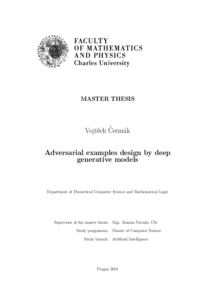Adversarial examples design by deep generative models
Tvorba nepřátelských vzorů hlubokými generativními modely
diplomová práce (OBHÁJENO)

Zobrazit/
Trvalý odkaz
http://hdl.handle.net/20.500.11956/127298Identifikátory
SIS: 212255
Kolekce
- Kvalifikační práce [11561]
Autor
Vedoucí práce
Oponent práce
Pilát, Martin
Fakulta / součást
Matematicko-fyzikální fakulta
Obor
Umělá inteligence
Katedra / ústav / klinika
Katedra teoretické informatiky a matematické logiky
Datum obhajoby
22. 6. 2021
Nakladatel
Univerzita Karlova, Matematicko-fyzikální fakultaJazyk
Angličtina
Známka
Výborně
Klíčová slova (česky)
Hluboké učení|klasifikace|generativní modely|nepřátelské vzoryKlíčová slova (anglicky)
Deep learning|classification|generative models|adversarial examplesV této práci zkoumáme možnost tvorby nepřátelských vzorků pomocí generativních modelů. Použijeme generativní modely k vytvoření nepřátelských vzorků pomocí perturbace latentních vektorů a využití některých vlastností klasifikátoru. Součástí práce je návrh dvou algoritmů. První algoritmus využívá lineární interpolace v kombinaci s bisekcí k získání vzorků z rozhodovací hranice klasifikátoru. Druhý využívá gradient k vytvoření potenciálně nepřátelských vzorků, podobně jako algoritmus FGSM. Tyto algoritmy použijeme na datasety MNIST, SVHT a CIFAR a vytvoříme sadu potenciálně nepřátelských vzorků a ukážeme, že v nich existují vzorky, které člověk klasifikuje jinak než stroj. Dále ukážeme, že náš typ útoku dokáže obejít bežně používané obrany.
In the thesis, we explore the prospects of creating adversarial examples using various generative models. We design two algorithms to create unrestricted adversarial examples by perturbing the vectors of latent representation and exploiting the target classifier's decision boundary properties. The first algorithm uses linear interpolation combined with bisection to extract candidate samples near the decision boundary of the targeted classifier. The second algorithm applies the idea behind the FGSM algorithm on vectors of latent representation and uses additional information from gradients to obtain better candidate samples. In an empirical study on MNIST, SVHN and CIFAR10 datasets, we show that the candidate samples contain adversarial examples, samples that look like some class to humans but are classified as a different class by machines. Additionally, we show that standard defence techniques are vulnerable to our attacks.
